 |
| by Mark
Steele - Auckland, New Zealand
The mess man
maketh, yet there is still
pleasure to be found!
|
It should be the first month of a beautiful,
fresh and unspoilt New Year, instead of that (and
I realize that this has nothing directly to do with
model sailboating), as I open the morning newspaper,
a picture confronts me of a crab covered in thick
oil struggling to come out of once pristine, now oil-polluted
water near Beirut. It sparks the personal comment,
“what a bloody mess man maketh of this planet
!” However, back to the little boats, what’s
left of the world is still worth enjoying, so get
your model yacht, find your patch of golden un-polluted
waterway and go sailing!
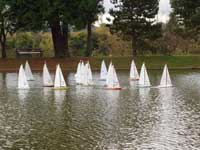
click images to enlarge |
Most countries
are blessed with small lakes, canals, ponds
and rivers, and the pleasure of sailing model
sailboats where the sails are often reflected
on the water and the ripple of the boats wake
and the occasional chirp of a bird overhead
are the only sounds, make for a peaceful and
relaxing interlude, and a period of escape back
to our boyhood days. |
On now to things less depressing. I got to thinking
last August, (remembering that I write and send these
columns and the selected corresponding photos to Chuck
several months in advance) that there must be a few
viewing readers who would dearly love to get involved
in this wonderful hobby of model sailboating, but
can’t get started for one reason or another
- too many boats appeal to them and they can’t
decide, or they are afraid to make a start because
they don’t know sufficient about the hobby,
or about building the boats or even about the intricacies
of sail, some even, perhaps hesitant perhaps to ask?
They put the decision off again and again,( “next
month maybe !“) and the next month, and the
month after comes and goes. Getting that first boat
is the all important `first hurdle’ believe
me, and that is why I feel strongly that the idea
of purchasing a kitset model complete with all radio
control gear at a relatively inexpensive cost of a
few hundred dollars will result in getting one started,
actually `sailing.’ There are a couple of options,
buying a starter boat off someone else already sailing
and who is moving on to another boat, or going out
and buying, say a Thunder Tiger Victoria (left photo,
below) as an example, the last cost quoted being US$205.
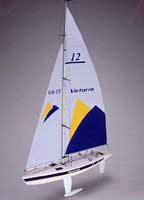 |
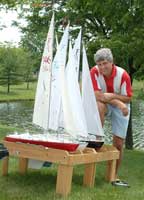 |
|
|
Alternatively, you could consider either a Kyosho
Fairwind, (see photo of Class Secretary Kerry Pebbles
and three of his own such boats). They are a 35.43”
long kitset boat fashioned after IOR racing yacht
designs of the 1980’ and 1990’ period,
or one of the Tippecanoe range of RC boats (like their
kitset complete with radio gear 37 RC Racing Yacht).
Any of these and you could be up and sailing down
at the pond before you know it. And the cost? - Round
about the US$250 mark for the latter.
Believe me, you’ll wonder why it took you so
long! Go to the Fairwind website online or to the
Tippecanoe site fun@modelsailboat.com That website
is a gem in itself! That’s three options to
think about. Model sailboating, I can almost guarantee
you’ll discover to be the most relaxing of pastimes.
I always like to remind people that the wind is still
free! (It is about the only thing that is, so don’t
delay as most Governments are probably considering
a `wind tax’ on how much of it we each breathe
and pondering on how to apply it!)
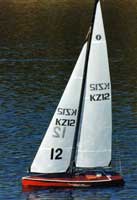 |
The first boat
you own is like an `icebreaker' - You've done
it and taken that step into a new world and
I am guessing that like me, you'll have that
first boat for a long time, perhaps forever
as you enjoy it, learn how to sail it, like
the writer even how to sail. And if it hasn't
got a name, for Gods sake give it one... model
boats just referred to as `it' or `the thing'
don't respond well!
|
I was in my late fifties when I took the plunge and
bought Fiji Flyer, an unsailed International
1M Bantock `Bikini’, a boat that to this day
I still own. I still happily sail it regularly. I
have never looked back and though I have other boats,
sentiment and the fact that Fiji Flyer still
sails so damn wonderfully, dictate that twenty-odd
years later I keep this boat up and running.
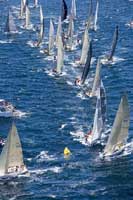 |
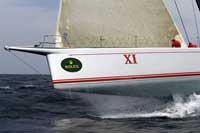 |
Wild
Oats XI again took line honours for the
second year running. Photograph by Carlo Borlenghi
Rolex |
One annual event I always look forward to –
the Rolex Sydney to Hobart Yacht Race, prompts me
to say that the website affords a superb facility
for those wanting to keep up with the state of play,
and to know pretty well the positions of boats in
the fleet in this 628 nm Antipodean bluewater classic
(photos above). I registered in order to be able to
use this impressive photograph taken by Daniel Forster-Rolex
of the front runners in 2006 race heading for the
first mark, much of the 78 strong fleet strung out
behind. Ocean racing tests the mettles of boats and
crews and the Rolex Sydney to Hobart event, part of
a big Rolex yacht racing sponsorship programme is
a `must follow’ event that starts on Australia
and New Zealand’s Boxing Day.
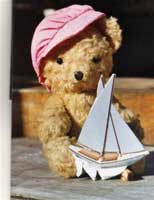 |
Well Phil Bolger designed
and built a folding schooner, so..." |
Over to the Netherlands now, where my friend, Hans
Staal builds beautiful models, specializing in his
interest in the traditional working vessels of times
gone by. He is also a brilliant photographer of model
sailing boats which he goes to extraordinary lengths
to capture at the right level and angle where the
end result often makes the view ponder as to whether
the subject is in fact a model or a real boat.
Hans often gets into the water to get the camera
at eye-level or lies prone to await the right moment
as these two photographs clearly show. His latest
model completed last year is of a Garnalenschuit,
flat-bottomed from the 1700-1900 period where they
were used for shrimp fishing on the North Sea coast
of the Netherlands. Their hulls had to be massively
constructed because at that time, Scheveningen had
no harbour and the boats had to be beached in front
of the village.
The model is built to an overall 60 cm hull length
with an all-up weight of 6kg when the false keel has
been attached. Built out of oak, the deck is pitch
pine, the boom and bowsprit of Oregon pine, the sails
of cotton. Four channel RC is used and Hans sails
the model (in up to wind force 4 breezes on a lake
just 2km from the North Sea. Hans choice of models
for his projects, is a good reminder to `build the
type of boat that pleases you, rather than a boat
that pleases others!’
Except for a wee write-up in a previous column on
the Townson Electron` Round the Island (of
Toberua) Race’ I haven’t made comment
about the other side of model yachting near and dear
to many, the International racing Classes particularly
the One Metres. I got started in model yachts in this
area here in New Zealand sailing in a couple of the
`Nationals’ regattas and involved more as a
sponsors representative for the first six years of
the (New Zealand) class Championships.
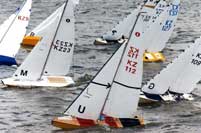 |
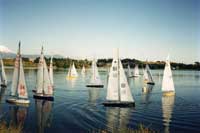
|
Serious racing continues to be very popular, particularly
with the one meter boats, drawing intently- competitive-minded
model sailors, many of whom take it very seriously
indeed. Many arm themselves with racing rules ad-infinitum
which they are expected to know, this often resulting
in post-race protests and `hearings’. Whether
the situation has improved or become progressively
worse I am unaware, because I no longer keep up with
the racing side and I am sure that there are a great
many such regattas totally free of agro and regrettable
behaviour.
That is not to knock this aspect of model yachting
for we are all different, in fact. were competitive
events not in existence there would be no winners
and indeed no champions in any sport whatsoever. There
is a great deal online on the various International
classes of model yachting, and if you spent some time
on the American Model Yachting Association website
you will be blown away as you discover how many classes
there are, including one for those little 12”
Footy’s mentioned in last months column. There
is such a choice, indeed I’d have to say that
the model yacht sailors of today never had it so good.
Anyone seen the ball of string? Dave Shull
a `Salvation Army pastor in Colorado (seen below)`builds
small’, and shows that even without radio control,
instead using the simple method of line control,
`thinking small’ can still provide boats of
great appeal and lots of inexpensive fun. They can
be sailed `offshore’ also, the limitations being
only the length of string tied to the stern, and the
eyesight of the person sailing them. It is just another
form of model sailing of which there are many. The
schooner (Titan) is just 16 inches overall,
the hull of cedar, shopping bags for sails, balsa
deck and cabin and skewer sticks for booms. The kite
string is attached to 8lb fishing line.
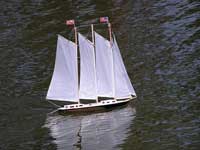 |
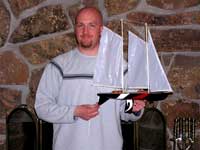
|
Hugh Hallston in South Carolina, USA (seen below)
has built a couple of boats, the `crème de
la crème’ being his Katrina
which he is seen with in the photograph. Boats of
this size have their drawbacks, (like where does one
store them?), but on the water they win the `Sex Appeal
Stakes’ hands down. Well I think so anyway!
You also see them better too when sailing them.
Thank you for your interest, and I Look forward to
the next journey with you to wherever the winds
may be blowing!
Mark Steele

Previous Columns by Mark Steele:
Articles by Mark Steele:

|